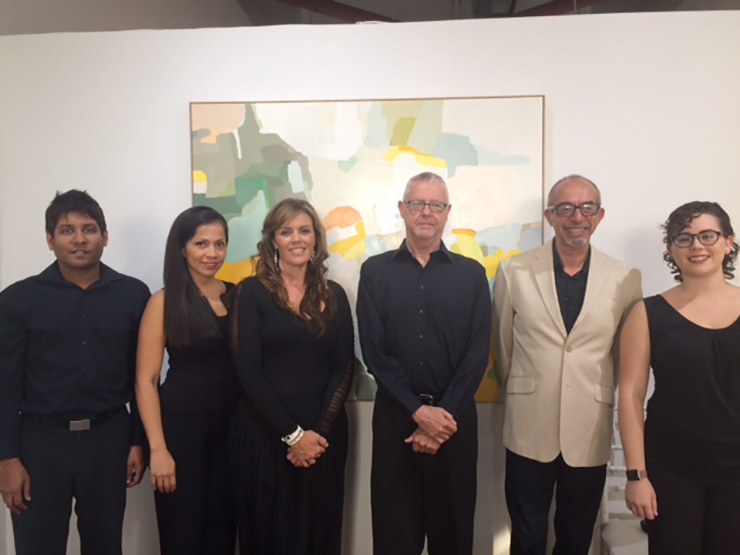
Not every major city can claim its own string quartet. Miami can.
Last Sunday, Mother’s Day, the tranquil Miami Beach Botanical Garden was the backdrop for the South Beach Chamber Ensemble program styled “The Latin Americans.” They also performed the package at local venues Art Bastion and Betsy Hotel on either side of the Mom’s Day event.
Now in its 20th year, the SBCE musicians include Tony Seepersad, violin; Ericmar Perez, violin; Amanda Diaz, viola; and SBCE’s founding director, Michael Andrews, cello.
The entire program included all living composers.
“Life is a Dream” (“La vida es sueño”) by composer Miguel del Águila was a study of his own consciousness (or subconsciousness), having identified with the main character from Calderón de la Barca’s play of the same name. Apparently both Águila and Barca’s character came to the realization that they could no longer tell reality from dreams, Águila stating that he set out “to blur and confuse the boundaries between the real and the imagined“ with his music. Pulling from 17th century Spanish modes, Águila musically fleshed out his introspective composition.
First violinist Seepersad opened with a solo dissonant strain, sublimely applying both the rich bottom and ultimate highs of his instrument, supported by deep pizzicatos. The violins eerily rummaged their upper register as the lower voices stirred, narrator Paul Seligmann reciting verses from Barca’s poem, conflating the spoken word with the music.
“What is life? A frenzy.
What is life? An illusion,
a shadow, a fiction…”
A pizzicato dance melody emerged, Latin in texture, livening the mood, developing in all four voices of the quartet. Seepersad and Perez passionately maintained the melody as another pizzicato item ran through the voices.
Seligmann concluded, and a dissonant rise gave over to the pizzicato theme.
“…for all life is a dream,
and dreams themselves are only dreams.”
“Tenebrae” (“Darkness”) by Osvaldo Golijov opened with a cello solo, Andrews rendering the somber item with resonant melancholy. All the voices melodically huddled together, slowly reaching upward, and then surrounded the cello again with a sustained rhythmic heartbeat. SBCE remained consistent and cohesive through the baroquely textured piece, while Andrews skillfully fulfilled Golijov’s direction for the solo: “…infinitely slow, but with melodic direction and energy, as an object in cosmic orbit."

Not only does this string engine playing at a world class caliber, they are fostering new music for the string genre.
The pieces presented in the second half of the program were written specifically for SBCE by composer Al Torrente: “Hospital Suite” and “Manisero Fantasy.” Joining the quartet was Angela Maleh on cello to acquit effectively the Torrente compositions, which required a string quintet.
When Torrente entered a hospital for a surgical procedure, his creative juices entered along with him, resulting in a three-movement quintet to memorialize the experience.
The first movement of his “Hospital Suite” titled “Going Under,” beginning with a mysterious pizzicato leading into a pensive study in the upper voices, seemed to characterize the cloudy uncertainty that besets someone as anesthesia begins to take hold. Maleh beautifully played her cello with the opening melody “Coming Out of It,” passing it to Andrews, all five players connecting well throughout the second movement.
“Recovery” implies several stages, and thus the clever fugue started with Andrews, ran through Perez, Seepersad, Diaz and then through Maleh. This mix of measured melody, delicately rendered by these players, had the patient awakening in peace.
Torrente’s “Manisero Fantasy” (“The Peanut Vendor”) grabbed hold of the very recognizable “El Manisero” melody recorded in 1930 by the Havana Casino Orchestra, a tune based on a street-seller's cry, which caused a 'rumba craze' in the US and Europe.
The ensemble began tapping the front and top of their instruments, every player adding to the percussion. The violins established the pizzicato rhythm at the top, Maleh happily taking the first shot at the popular melody, the contagious tune moving buoyantly from player to player. Andrews blew his authentic samba whistle, springing all five instruments into action twisting and turning the familiar melody. The intimate audience appeared to be having as much fun as the players.
Andrews mentioned that “As we enter our 20th season this fall I am appreciative of all who have supported our ‘Music in Beautiful Spaces,’” referring to several Miami based organizations and SBCE’s loyal fans.
The size of SBCE’s audiences tends to be small but certainly not reflective of the size of their music. Any classical music enthusiast is well-served to take in a future SBCE concert.
For information on SBCE and its future offerings go to www.sobechamberensemble.org
 MAIN MENU
MAIN MENU

